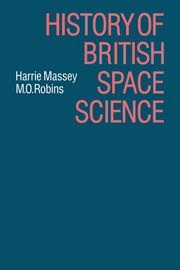Book contents
- Frontmatter
- Contents
- Glossary of abbreviations in text and annexes
- Glossary of abbreviations in appendices
- Preface
- 1 The scientific background
- 2 The technical background
- 3 The initiation of the Skylark rocket programme – the IGY and artificial satellites
- 4 Post-IGY developments – NASA – COSPAR – British National Committee for Space Research – British satellite experiments
- 5 The Ariel programme
- 6 The European Space Research Organization
- 7 Commonwealth co-operation in space reseach
- 8 Smaller rockets for scientific purposes – Skua and Petrel
- 9 Attitude controlled Skylark rockets
- 10 The Trend Committee and the Science Research Council
- 11 The transformation of ESRO into ESA
- 12 The Space Science Committee for Europe
- 13 Scientific studies by British space scientists – figure of the earth and the neutral atmosphere
- 14 Scientific studies by British space scientists – the ionosphere, the magnetosphere and cosmic rays
- 15 The contribution from British space scientists to astronomy
- 16 Concluding remarks
- Appendices
- Annexes
- Notes
- Index
6 - The European Space Research Organization
Published online by Cambridge University Press: 05 February 2012
- Frontmatter
- Contents
- Glossary of abbreviations in text and annexes
- Glossary of abbreviations in appendices
- Preface
- 1 The scientific background
- 2 The technical background
- 3 The initiation of the Skylark rocket programme – the IGY and artificial satellites
- 4 Post-IGY developments – NASA – COSPAR – British National Committee for Space Research – British satellite experiments
- 5 The Ariel programme
- 6 The European Space Research Organization
- 7 Commonwealth co-operation in space reseach
- 8 Smaller rockets for scientific purposes – Skua and Petrel
- 9 Attitude controlled Skylark rockets
- 10 The Trend Committee and the Science Research Council
- 11 The transformation of ESRO into ESA
- 12 The Space Science Committee for Europe
- 13 Scientific studies by British space scientists – figure of the earth and the neutral atmosphere
- 14 Scientific studies by British space scientists – the ionosphere, the magnetosphere and cosmic rays
- 15 The contribution from British space scientists to astronomy
- 16 Concluding remarks
- Appendices
- Annexes
- Notes
- Index
Summary
In Chapter 4 we described how British scientists were able to carry out experiments with equipment in satellites through bilateral co-operation with the United States in the Ariel programme. Although this provided opportunities which were immediately available and opened the way to further involvement in the US programme it did not fully satisfy the demand from the British space science community. The possibility of a national satellite launching programme involving the Blue Streak–Black Knight combination was still being actively canvassed in 1960 but, in addition, two other possibilities of co-operation were feasible, with the Commonwealth and with Western Europe. In a sense, Commonwealth co-operation was already involved through the use of Woomera in Australia for launching Skylark. This would also be true of a launching programme using Blue Streak because again the launching site would be at Woomera. The possibility of wider Commonwealth co-operation was actively canvassed during 1959 but although collaboration in space science did develop it was through the use of sounding rockets and did not add to satellite facilities. Its development will be described in the next chapter.
With Western Europe, on the other hand, very significant developments did take place which increased very considerably the opportunities for satellite experiments. Early in 1959 a suggestion was made that the North Atlantic Treaty Organization might organize a space research programme. There were obvious objections to this because of the military associations.
- Type
- Chapter
- Information
- History of British Space Science , pp. 108 - 162Publisher: Cambridge University PressPrint publication year: 1986



